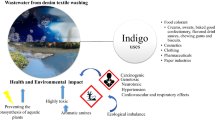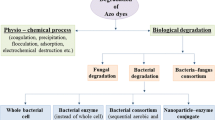Abstract
Sesuvium portulacastrum is a common halophyte growing well in adverse surroundings and is exploited mainly for the environmental protection including phytoremediation, desalination and stabilization of contaminated soil. In the present investigation, attempts have been made on the decolorization of a toxic textile dye Green HE4B (GHE4B) using in vitro grown Sesuvium plantlets. The plantlets exhibited significant (70%) decolorization of GHE4B (50 mg l−1) that sustain 200 mM sodium chloride (NaCl) within 5 days of incubation. The enzymatic analysis performed on the root and shoot tissues of the in vitro plantlets subjected to GHE4B decolorization in the presence of 200 mM NaCl showed a noteworthy induction of tyrosinase, lignin peroxidase and NADH-DCIP reductase activities, indicating the involvement of these enzymes in the metabolism of the dye GHE4B. The UV–visible spectrophotometer, HPLC and Fourier Transform Infrared Spectroscopy (FTIR) analyses of the samples before and after decolorization of the dye confirmed the efficient phytotransformation of GHE4B in the presence of 200 mM NaCl. Gas Chromatography–Mass Spectroscopy (GC–MS) analysis of the products revealed the formation of three metabolites such as p -amino benzene, p -amino toluene and 1, 2, 7-amino naphthalene after phytotransformation of GHE4B. Based on the FTIR and GC–MS results, the possible pathway for the biodegradation of GHE4B in the presence of 200 mM NaCl has been proposed. The phytotoxicity experiments confirmed the non-toxicity of the degraded products. The present study demonstrates for the first time the potential of Sesuvium for the efficient degradation of textile dyes and its efficacy on saline soils contaminated with toxic compounds.






Similar content being viewed by others
Abbreviations
- BAP:
-
Benzyl aminopurine
- FTIR:
-
Fourier Transform Infrared Spectroscopy
- GC–MS:
-
Gas chromatography mass spectroscopy
- GHE4B:
-
Green HE4B
- HPLC:
-
High-performance liquid chromatography
- LiP:
-
Lignin peroxidase
- MS:
-
Medium Murashige and Skoog medium
- NAA:
-
α-Napthaleneacetic acid
- NaCl:
-
Sodium chloride
- NADH-DCIP:
-
Dichlorophenol indophenol
References
Aubert S, Schwitzguebel JP (2004) Screening of plant species for the phytotreatment of wastewater containing sulfonated anthraquinones. Water Res 38:3569–3575
Bestani B, Benderdouche N, Benstaali B, Belhakem M, Addou A (2008) Methylene blue and iodine adsorption onto an activated desert plant. Bioresour Technol 99:8441–8444
Carias CC, Novais JM, Martins-Dias S (2008) Are Phragmites australis enzymes involved in the degradation of the textile azo dye Acid orange 7? Bioresour Technol 99:243–251
Casieri L, Varese GC, Anastasi A, Prigione V, Svobodova K, Marchisio VF, Novotny C (2008) Decolorization and detoxification of reactive industrial dyes by immobilized fungi Trametes pubescens and Pleurotus ostreatus. Folia Microbiol 53:44–52
Cluis C (2004) Junk-greedy greens: phytoremediation as a new option for soil decontamination. Biotechnol J 2:61–67
Cunningham SD, Berti WR (2000) Phytoextraction and phytostabilization: technical, economic, and regulatory considerations of the soil-lead issue. In: Terry N, Banuelos G (eds) Phytoremediation of contaminated soil and water. CRC Press, Boca Raton, pp 359–376
Daneshvar N, Ayazloo M, Khataee A, Pourhassan M (2007) Biological decolorization of dye solution containing malachite green by microalgae Cosmarium sp. Bioresour Technol 98:1176–1182
Davies LC, Carias CC, Novais JM, Martins-Dias S (2005) Phytoremediation of textile effluents containing azo dye by using Phragmites australis in a vertical flow constructed intermittent feeding constructed wetland. Ecol Eng 25:594–605
Doran PM (2009) Application of plant tissue cultures in phytoremediation research: incentives and limitations. Biotechnol Bioeng 103:60–76
Eapen S, D’Souza SF (2005) Prospects of genetic engineering of plants for phytoremediation of toxic metals. Biotechnol Adv 23:97–114
Ghnaya T, Slama I, Messedi D, Grignon C, Ghorbel MH, Abdelly C (2005) Cd-induced growth reduction in the halophyte Sesuvium portulacastrum is significantly improved by NaCl. J Plant Res 120:309–316
Ghnaya T, Slama I, Messedi D, Grignon C, Ghorbel MH, Abdelly C (2007) Effect of Cd2+ on K+, Ca+ and N uptake in two halophytes Sesuvium portulacastrum and Mesembrynathemum crystallinum: consequences on growth. Chemosphere 67:72–79
Ghodake GS, Telke AA, Jadhav JP, Govindwar SP (2009) Potential of Brassica juncea in order to treat textile effluent contaminated sites. Int J Phytorem 11:297–312
Guillon S, Tremouillaux-Guiller J, Pati PK, Gantet P (2008) Hairy roots: a powerful tool for plant biotechnological advances. In: Ramawat KH, Merillon LM (eds) Bioactive molecules and medicinal plants. Springer, Berlin, pp 271–283
Hu MR, Chao YP, Zhang GQ, Xue ZH, Qian S (2009) Laccase-mediator system in the decolorization of different types of recalcitrant dyes. J Ind Microbiol Biotechnol 36:45–51
Kagalkar AN, Jagatap UB, Jadhav JP, Bapat VA, Govindwar SP (2009) Biotechnological strategies for phytoremediation of the sulphonated azo dye Direct Red 5B using Blumea malcolmii Hook. Bioresour Technol 100:4104–4110
Kagalkar AN, Jagtap UB, Jadahv JP, Govindwar SP, Bapat VA (2010) Studies on phytoremediation potentiality of Typhonium flagelliforme for the degradation of Brilliant blue R. Planta 232:271–285
Kalme SD, Jadhav SU, Parshetti GK, Govindwar SP (2009) Biodegradation of Green HE4B: co-substrate effect, biotransformation enzymes and metabolite toxicity analysis. Ind J Microbiol 50:156–164
Lokhande VH, Nikam TD, Suprasanna P (2009a) Sesuvium portulacastrum (L.) L., a promising halophyte: cultivation, utilization and distribution in India. Genet Resour Crop Evol 56:741–747
Lokhande VH, Patade VY, Nikam TD, Suprasanna P (2009b) Morphological and molecular diversity analysis among the Indian clones of Sesuvium portulacastrum L. Genet Resour Crop Evol 56:705–717
Lokhande VH, Srivastava S, Patade VY, Dwivedi S, Tripathi RD, Nikam TD, Suprasanna P (2010a) Investigation of arsenic accumulation and tolerance in Sesuvium portulacastrum (L.) L. Chemosphere doi:10.1016/j.chemosphere.2010.10.059
Lokhande VH, Nikam TD, Patade VY, Ahire ML, Suprasanna P (2010b) Effects of optimal and supra-optimal salinity stress on antioxidative defence, osmolytes and in vitro growth responses in Sesuvium portulacastrum L. Plant Cell Tiss Org Cult. doi: 10.1007/s11240-010-9802-9
Lokhande VH, Nikam TD, Ghane SG, Suprasanna P (2010c) Studies on the response of growth regulators for in vitro culture and clonal behavior of six clones of a halophyte, Sesuvium portulacastrum L. Physiol Mol Biol Plants 16:187–193
Mackova M, Chroma L, Kucerova P, Burkhard J, Demnerova K, Macek T (2001) Some aspects of PCB metabolism by horseradish cells. Int J Phytoremediat 3:401–414
Mohandass R, Bhaskar A, Kalavathy S, Devilaksmi S (2007) Biodecolorization and biodegradation of Reactive blue by Aspergillus sp. Afr J Biotechnol 6:1441–1445
Moorthi SP, Selvam PS, Sasikalaveni A, Murugesan K, Kalaichelvan PT (2007) Decolorization of textile dyes and their effluents using white rot fungi. Afr J Biotechnol 6:424–429
Moseki B, Buru JC (2010) Ionic and water relations of Sesuvium portulacastrum (L). Sci Res Essay 5:35–40
Murashige T, Skoog F (1962) A revised medium for the rapid growth and bioassays with tobacco cultures. Physiol Plant 15:473–497
Padmavathiamma PK, Loretta YL (2007) Phytoremediation technology: hyper accumulation metals in plant. Water Air Soil Pollut 184:105–126
Paszcezynski A, Pasti-Grigsby M, Goszceynski S, Crawford R, Crawford DL (1992) Mineralization of sulfonated azo dyes and sulfanilic acid by Phanerochaete chrysosporium and Streptomyces chromofuscus. Appl Environ Microbiol 58:3598–3604
Patil PS, Desai NS, Govindwar SP, Jadhav JP, Bapat VA (2009) Degradation analysis of Reactive red 198 by hairy roots of Tagetes patula L. (Marigold). Planta 230:725–735
Rabhi M, Hafsi C, Lakhdar A, Barhoumi Z, Hamrouni MH, Abdelly C, Smauoi A (2009) Evaluation of the capacity of three halophytes to desalinize their rhizosphere as grown on saline soils under nonleaching conditions. Afr J Ecol 47:463–468
Rabhi M, Giuntini D, Castagna A, Remorini D, Baldan B, Smaoui A, Abdelly C, Ranieri A (2010) Sesuvium portulacastrum maintains adequate gas exchange, pigment composition, and thylakoid proteins under moderate and high salinity. J Plant Physiol. doi:10.1016/j.jplph.2010.05.009
Robinson T, McMullan G, Marchant R, Nigam P (2001) Remediation of dyes in textile effluent: a critical review on current treatment technologies with a proposed alternative. Bioresour Technol 77:247–255
Salokhe MD, Govindwar SP (1999) Effect of carbon source on the biotransformation enzymes in Serratia marcescens W. J Microbiol Biotechnol 15:229–232
Salt DE, Smith RD, Raskin I (1998) Phytoremediation. Annu Rev Plant Physiol Plant Mol Biol 49:643–668
Shedbalkar UU, Dhanve RS, Jadhav JP (2008) Biodegradation of Cotton blue by Penicillium ochrochloron MTCC 517. J Hazardous Mat 157:472–479
Shedbalkar UU, Jadhav JP (2011) Detoxificatiion of Malachite green and textile industrial effluent by Penicillium ochrochloron. Biotechnol Bioprocess Engin 16:196–204
Singh S, Kang SH, Mulchandani A, Chen W (2008) Bioremediation: environmental clean-up through pathway engineering. Curr Opin Biotechnol 19:437–444
Zaier H, Ghnaya T, Lakhdar A, Baioui R, Ghabriche R, Mnasri M, Sghair S, Lutts S, Abdelly C (2010a) Comparative study of Pb-phytoextraction potential in Sesuvium portulacastrum and Brassica juncea: tolerance and accumulation. J Hazardous Mat. doi:10.1016/j.jhazmat.2010.07.068
Zaier H, Mudarra A, Kutscher D, Fernandez de la Campa MR, Abdelly C, Sanz-Medel A (2010b) Induced lead binding phytochelatins in Brassica juncea and Sesuvium portulacastrum investigated by orthogonal chromatography inductively coupled plasma-mass spectrometry and matrix assisted laser desorption ionization-time of flinve-mass spectrometry. Anal Chimica Acta. doi:10.1016/j.aca.2010.04.054
Zhang X, Flurkey W (1997) Phenol oxidase in Portabella mushrooms. J Food Sci 62:97–100
Acknowledgment
AVP and JPJ wish to thank University Grant Commission, New Delhi for SAP-DRS-1 support.VAB wishes to thank Council of Scientific and Industrial Research, New Delhi for Emeritus Scientist Fellowship.
Author information
Authors and Affiliations
Corresponding author
Additional information
The authors A. V. Patil and V. H. Lokhande contributed equally for the manuscript.
Rights and permissions
About this article
Cite this article
Patil, A.V., Lokhande, V.H., Suprasanna, P. et al. Sesuvium portulacastrum (L.) L.: a potential halophyte for the degradation of toxic textile dye, Green HE4B. Planta 235, 1051–1063 (2012). https://doi.org/10.1007/s00425-011-1556-z
Received:
Accepted:
Published:
Issue Date:
DOI: https://doi.org/10.1007/s00425-011-1556-z




